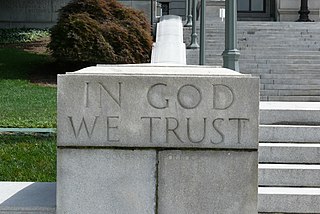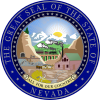
The Great Seal is a principal national symbol of the United States. The phrase is used both for the physical seal itself, which is kept by the United States Secretary of State, and more generally for the design impressed upon it. The obverse of the Great Seal depicts the national coat of arms of the United States.

The coat of arms of the state of New York was formally adopted in 1778, and appears as a component of the state's flag and seal.

The Great Seal of the State of Kansas tells the history of Kansas.

Annuit cœptis is one of two mottos on the reverse side of the Great Seal of the United States. The literal translation is "favors [our] undertakings", from Latin annuo, and coeptum. Because of its context as a caption above the Eye of Providence, the standard translations are "Providence favors our undertakings" and "Providence has favored our undertakings".

The flag of the state of Vermont displays the coat of arms and motto of Vermont on a rectangular blue background. The Vermont General Assembly adopted this flag on June 1, 1923.

The Eye of Providence is a symbol that depicts an eye, often enclosed in a triangle and surrounded by rays of light or glory, meant to represent divine providence, whereby the eye of God watches over humanity. A well-known example of the Eye of Providence appears on the reverse of the Great Seal of the United States, which is depicted on the United States one-dollar bill.

The Seal of the State of Colorado is an adaptation of the territorial seal which was adopted by the First Territorial Assembly on November 6, 1861. The only changes made to the territorial seal design being the substitution of the words, "State of Colorado" and the figures "1876" for the corresponding inscriptions on the territorial seal. The first General Assembly of the State of Colorado approved the adoption of the state seal on March 15, 1877. The Colorado Secretary of State alone is authorized to affix the Great Seal of Colorado to any document whatsoever.

The state of New Hampshire has held two seals since it declared its independence from Great Britain on January 5, 1776. While both seals have been retained, most people are only familiar with the Great Seal due to its corporate use.

The Seal of the Confederate States was used to authenticate certain documents issued by the federal government of the Confederate States. The phrase is used both for the physical seal itself, and more generally for the design impressed upon it. On May 20, 1863, C.S. Secretary of State Judah Benjamin instructed James Mason to arrange for its manufacture in London. The seal was first used publicly in 1864.

The state seal of New York features the state arms surrounded by the words "The Great Seal of the State of New York". A banner below shows the New York State motto Excelsior, Latin for "Ever Upward", and the secondary motto E Pluribus Unum, Latin for "Out of Many, One"—adopted in 2020.

The Great Seal of the State of Connecticut has been the coat of arms of the U.S. state of Connecticut since May 1784. It depicts three grapevines and a ribbon below with the Latin motto: Qui Transtulit Sustinet, with SIGILLUM REIPUBLICÆ CONNECTICUTENSIS in the border.

The Great Seal of the State of Arizona. According to Article 22, Section 20 of the State of Arizona Constitution by the Arizona State Legislature:

The seal of the Territory of Idaho was adopted in 1863 and redrawn several times before statehood in 1890. The state Great Seal was designed by Emma Edwards Green, the only woman to design a state seal.

The Great Seal of the State of Montana was adopted in 1865, when Montana was a United States Territory. When it became a state in 1889, it was decided to use the same seal. In 1891, proposals were made to make changes or adopt a brand new seal. None of these proposals passed legislation. The outer ring of the seal contains the text "The Great Seal of the State of Montana". The inner circle depicts a landscape of mountains, plains and forests by the Great Falls on the Missouri River. A plow, a pick and a shovel are depicted on the front, representing the state's industry. The banner at the bottom of the seal reads the territorial motto of Oro y Plata, meaning "Gold and Silver" in Spanish. Montana also has many popular unofficial mottos including "The last best Place" and "Big Sky Country"

The Great Seal of the State of Nebraska was adopted by the Nebraska legislature on June 15, 1867. It depicts a blacksmith working at an anvil along with various other symbols related to Nebraska during the early days of its statehood.

The Great Seal of the State of Ohio is the official insignia of the U.S. state of Ohio. All governmental offices, agencies, and courts in Ohio use variations of the state seal. Its primary feature is a circular coat of arms that depicts a sunrise in Chillicothe, Ohio's first capital, along with symbols of the state's origins. The seal sometimes appears with the state motto, "With God, all things are possible".

The Seal of the State of Oregon is the official seal of the U.S. state of Oregon. It was designed by Harvey Gordon in 1857, two years before Oregon was admitted to the Union. The seal was preceded by the Salmon Seal of the Provisional Government and the Seal of the Oregon Territory. The state seal is mandated by Article VI of the Oregon Constitution.

The coat of arms of Vermont is the official armorial bearings of the U.S. state of Vermont. Most of the elements found in the coat of arms originate in the Great Seal of Vermont designed by Ira Allen. Whereas the Great Seal of Vermont is reproduced in a single color and is reserved for embossing and authenticating state documents, the coat of arms is a more naturalistic and colorful representation of many of the same elements. The Coat of arms of Vermont was first used in 1807 on $5 bank notes of The Vermont State Bank. One of these notes is in the special collections of the Vermont History Center in Barre, Vermont. Prior to the discovery of the 1807 banknotes, the earliest representation of the coat of arms of Vermont was found on an engraved 1821 state military commissions. The exact designer is not known, but it is likely that then Secretary of State Robert Temple worked with an engraver in developing the arms. Considerable liberties were taken in early depictions of the coat of arms. The location of the cow and the sheaves moved about the foreground, and the height of the pine tree and size of the buck's head also varied. A state statute was approved in 1840, and modified in 1862, both attempts to codify and create more consistent representation of the arms. The coat of arms was cast in brass to ornament uniforms of Vermont's military regiments before, and through the U.S. Civil War, when individual states raised and trained their own regiments.

The modern motto of the United States of America, as established in a 1956 law signed by President Dwight D. Eisenhower, is "In God we trust". The phrase first appeared on U.S. coins in 1864.






















